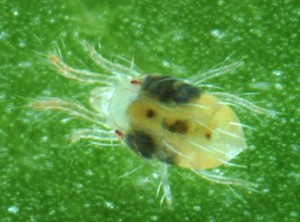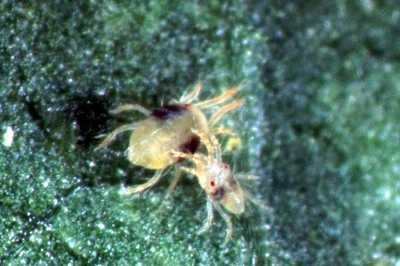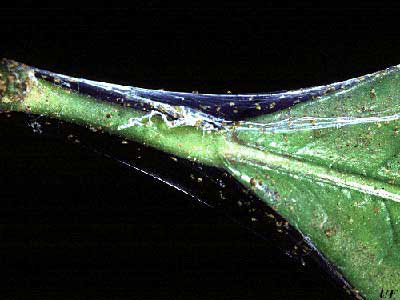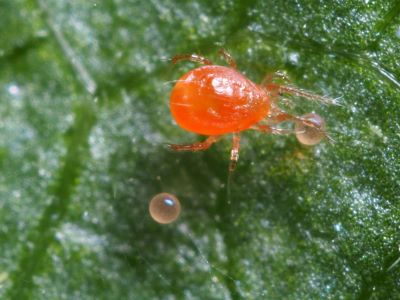Two-spotted mite
Two-spotted mites, also known as two-spotted spider mites (Tetranychus urticae) are found worldwide, including throughout Australia. They have an extremely wide host range and are readily spread by wind.
High population densities of the mites can cause severe crop damage and reductions in yield.
Description
Egg
The egg of the two-spotted mite is minute (about 0.14 mm), round and transparent when laid, becoming pale yellow-white later.
Juveniles
From the egg hatches a larva that has 6 legs, is pale yellowish-white, minute and oval. After eating, they change colour to yellow or green and 2 dark spots appear on the body. Following another period of feeding, the larva develops into an 8-legged nymph or protonymph.
This cycle of feeding and moulting is repeated, resulting in the deuteronymph and then an adult (see Life cycle).
Adult
The adult female is about 0.5 mm long, oval-shaped and rounded at the rear. Its colour can vary between orange, light and dark green, reddish brown and black, and is often dependent on the food crops. In the summer, adult females are typically yellowish-green, with 2 pronounced dark spots, one on either side of the body (Figure 1).
The adult male is smaller, about 0.3 mm long, and more pointed at the rear (Figure 2). Its colour varies from light yellow/orange to dark yellow/brown. In males these spots are less conspicuous. Both sexes possess 2 reddish eyespots.
All life stages are most often found on the underside of leaves.


Feeding damage
Nymphs and adults damage plant foliage by piercing the cells and sucking the contents, causing chlorotic spots that give the leaf a stippled appearance (Figure 3).

Heavily infested leaves can turn yellow or bronzed, and shrivelled, decreasing the surface area for photosynthesis and leading to tree decline. Two-spotted mite is also a profuse web-spinner in its active stages. The webbing helps protect the mites from pesticides and predators (Figure 4).

The mites are particularly damaging in hot, dry weather. Plants near dust sources such as dirt roads are particularly susceptible to mite attack.
Hosts
Two-spotted mite is a generalist feeder that targets many crop and ornamental plants.
Pear trees are particularly sensitive to mite damage and cultivars such as Williams or Bartlett develop dry brown areas on leaves in response to mite feeding. The leaves may drop prematurely in summer, but if this is followed by rain or irrigation the tree may flower again using buds that would have been reserved for the next season’s crop.
Life cycle
In hot dry weather, the life cycle of the two-spotted mite may be as short as 2 weeks and all stages may be found at one time (Figure 5).

Depending on the prevailing conditions a female can lay up to 6 eggs a day and a total of 70 or more in her lifetime. Hatching occurs 3 to 10 days later, depending on the temperature.
The larvae and nymphal stages mature in 4 to 12 days, depending on temperature, and may live for another 3 weeks or more.
Only males are produced from unfertilised eggs, whereas both males and females can develop from fertilised eggs.
Adult females can overwinter (hibernate), which is initiated by shortened day length, decreased temperatures and unfavourable food supply. Overwintering females stop feeding and egg-laying, become orange-red and move to shelters on the ground or under the bark of lower regions of trees.
Overwintering is terminated by increased temperatures in spring. The mites leave their overwintering sites and lose their reddish colour as they start to feed. Mites living in protected environments, such as glasshouses, do not hibernate over winter but continue to feed and reproduce.
Distribution and spread
Two-spotted mite is a cosmopolitan species, recorded in most countries in Europe, Asia, Africa, Australasia, the Americas and the Pacific and Caribbean islands.
The mites do not fly but can be passively transported by the wind or via movement of people, plants or tools.
Control
Chemical control
The use of broad-spectrum insecticides greatly reduces the number and effectiveness of beneficial insects, and mite populations have developed varying degrees of resistance to several miticides. If chemical control is required, careful selection of a miticide is important.
There are several effective miticides available but they may be phytotoxic to some plants. Small black mite-eating ladybird beetles (Stethorus) commonly attack two-spotted mites but tend to appear when mite populations are high and damage is already occurring. Several predatory mite species have been introduced as biocontrol agents against spider mites. Two-spotted mite has been successfully controlled in Victorian apple, pear and peach orchards by the use of an integrated approach in which chemicals are used in conjunction with the introduced predatory mite Galendromus occidentalis.
Chemical control is one of the methods available for plant pests as part of an integrated pest management program.
For information on currently registered and or permitted chemicals, check the Australian Pesticide and Veterinary Medicine Authority (APVMA) website. Always consult the label and safety data sheet before using any chemical product.
Biological control
The Chilean predatory mite Phytoseiulus persimilis is also widely used in horticultural crops to control two-spotted mite (Figure 6).

Neoseiulus californicus is another predatory mite used in biocontrol, as it is tolerant of Australian climatic conditions in fruit-growing areas.
G. occidentalis, P. persimilis and N. californicus are available from commercial biocontrol suppliers in Australia. These predatory mites are susceptible to different pesticides and growers are advised to obtain a list of pesticides toxic to the predators. Such lists are available from the suppliers of the predators.
Photo credits
- Figure 1: Thomas J Jenstch, Cornell University, New York.
- Figure 2: University of Warwick.
- Figure 3: Kansas State University
- Figure 4: James F Price, University of Florida.
- Figure 5: Courtesy of Sonia Broughton, DPIRD, WA.
- Figure 6: BugsforBugs
Reporting an unusual plant insect pest or disease
Report any unusual plant pest or disease immediately using our online reporting form or by calling the Exotic Plant Pest Hotline on 1800 084 881. Early reporting increases the chance of effective control and eradication.
Please take multiple good quality photos of the pests or damage to include in your report where possible, as this is essential for rapid pest and disease diagnosis and response.
Your report will be responded to by an experienced staff member, who may seek more information about the detection and explain next steps.
Report online